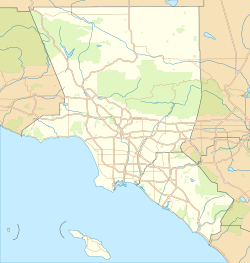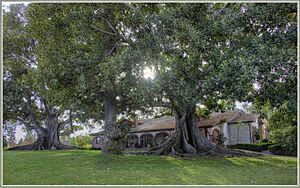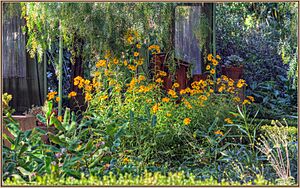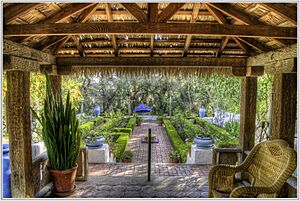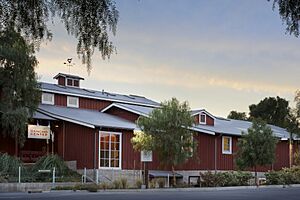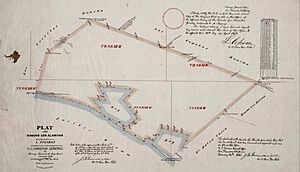Rancho Los Alamitos facts for kids
Quick facts for kids |
|
|
Rancho Los Alamitos
|
|
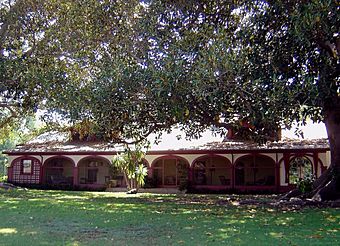
The main ranch house at Rancho Los Alamitos, pictured in 2008.
|
|
| Location | 6400 Bixby Hill Rd., Long Beach, California |
|---|---|
| Area | 7.4 acres (3.0 ha) |
| Built | between 1800 and 1834 |
| Architectural style | Spanish Colonial |
| NRHP reference No. | 81000153 |
| Added to NRHP | July 7, 1981 |
Rancho Los Alamitos is a historic ranch located in what is now Long Beach, California. Its name means "The Little Cottonwoods" in Spanish, named for the native Fremont Cottonwood trees that grew there. The story of this land is a journey through the history of California.
Long ago, this rancho was a massive piece of land. It covered areas that are now the cities of Long Beach, Los Alamitos, Seal Beach, and Garden Grove. Today, the original adobe ranch house still stands. It is now a museum where you can explore the area's fascinating past.
Contents
The Story of Rancho Los Alamitos
The history of this 28,000-acre rancho shows how much Southern California has changed over hundreds of years. It started as Native American land, became a Spanish and Mexican rancho, and finally an American farm.
From a Native Village to a Spanish Grant
Long before Europeans arrived, this area was home to the Tongva people. It was the site of a large and important village called Povuu'nga, which was a center for trade and ceremonies.
In the late 1700s, Spain controlled California. The Spanish government gave large areas of land, called ranchos, to loyal soldiers. In 1784, a soldier named Manuel Nieto received one of the biggest land grants, called Rancho Los Nietos. After Nieto passed away, his huge property was divided among his children. In 1834, one of these smaller pieces officially became Rancho Los Alamitos.
A New Owner and the Gold Rush
In 1844, a man from Massachusetts named Abel Stearns bought the rancho. Stearns became a very important figure in the area. He married Arcadia Bandini, whose family was well-known among the Californios (people of Spanish or Mexican descent living in California).
During the California Gold Rush that started in 1848, the rancho played a key role. It supplied beef to the thousands of people who rushed to Northern California to find gold. For a time, Rancho Los Alamitos was the headquarters for the largest cattle ranch in the United States.
After the Mexican-American War, California became part of the United States in 1850. The U.S. government agreed to honor the old Spanish and Mexican land grants. Abel Stearns officially became the owner of the nearly 28,000-acre rancho.
The Bixby Family Era
A major drought in the 1860s caused huge problems for cattle ranchers. Abel Stearns lost control of the rancho. For many years, the land was rented out to different farmers.
In the 1880s, the rancho was bought by John William Bixby and his partners. The Bixby family was already well-known for owning the nearby Rancho Los Cerritos. John Bixby had big plans. He started to develop a town called Alamitos Beach, which later became part of Long Beach.
Sadly, John Bixby died unexpectedly in 1888. The rancho was then split between his family, his cousins, and a business partner. The Bixby family continued to find new ways to use the land. They began growing sugar beets and even built a sugar factory. Later, oil was discovered on the land, which brought more wealth to the family.
Becoming a Museum
The Bixby family owned and lived on the rancho for many years. They loved the land and its history. In 1967, the family generously donated the main ranch house and 7.4 acres of land to the City of Long Beach. They wanted to make sure its history would be preserved for everyone to enjoy.
Visiting the Rancho Today
Today, Rancho Los Alamitos is a public museum and a registered National Historic Landmark. You can visit the original adobe ranch house, which was built in the early 1800s.
The house is surrounded by beautiful historic gardens. Some of these gardens were designed by famous landscape architects like Frederick Law Olmsted Jr.. Visitors can walk through the gardens, see the old barns, and learn what life was like on a California rancho. It's a peaceful escape that tells the story of the region's rich history.
See also
 In Spanish: Rancho Los Alamitos para niños
In Spanish: Rancho Los Alamitos para niños
- Los Cerritos Ranch House
- List of City of Long Beach Historic Landmarks
- List of Ranchos of California
- Ranchos of Orange County
- Ranchos of Los Angeles County


